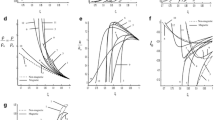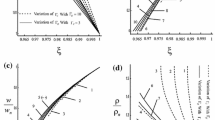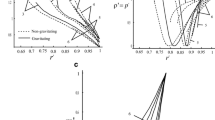Abstract
One-dimensional self-similar unsteady isothermal and adiabatic flows behind a strong exponential shock wave driven out by a cylindrical piston moving with time according to an exponential law in a rotational axisymmetric non-ideal gas is investigated. The medium is assumed to be non-ideal gas rotating about the axis of symmetry. The fluid velocities in the ambient medium are assumed to be varying with time according to an exponential law. Similarity solutions exist only when the surrounding medium is of constant density. Solutions are obtained, in both the cases, when the flow between the shock and the piston is isothermal or adiabatic by taking into account components of vorticity vector. It is found that the assumption of zero temperature gradient brings a profound change in the density and compressibility distributions as compared to that of the adiabatic case. The effect of an increase in the value of the parameter of the non-idealness of the gas is investigated. Also, a comparison between the solutions in the cases of isothermal and adiabatic flows is made. Further, it is shown that the consideration of zero temperature gradient and the effect of variation of the parameter of non-idealness of the gas decrease the shock strength and widens the disturbed region between the shock and piston. The shock waves in non-ideal gas can be important for description of shocks in supernova explosions, in the study of a flare produced shock in solar wind, central part of star burst galaxies, nuclear explosion, rupture of pressurized vessel, in the analysis of data from exploding wire experiments, and cylindrically symmetric hypersonic flow problems associated with meteors or reentry vehicles, etc. The findings of the present work provided a clear picture of whether and how the non-idealness of the gas and consideration of zero temperature gradient affect the propagation of shock and the flow behind it.




Similar content being viewed by others
References
Das TK (2002) Generalized shock solutions for hydrodynamic black hole accretion. Astrophys J 577:880–892
Das TK, Pendharkar JK, Mitra S (2003) Multitransonic black hole accretion disks with isothermal standing shocks. Astrophys J 592:1078–1088
Sedov LI (1982) Similarity and dimensional methods in mechanics. Mir Publishers, Moscow
Zel’dovich YB, Raizer YP (1967) Physics of shock waves and high temperature hydrodynamic phenomena, vol II. Academic Press, New York
Lee TS, Chen T (1968) Hydromagnetic interplanetary shock waves. Planet Space Sci 16:1483–1502
Summers D (1975) An idealized model of a magnetohydrodynamic spherical blast wave applied to a flare produced shock in the solar wind. Astron Astrophys 45:151–158
Chaturani P (1970) Strong cylindrical shocks in a rotating gas. Appl Sci Res 23:197–211
Sakurai A (1956) Propagation of spherical shock waves in stars. J Fluid Mech 1:436–453
Nath O, Ojha SN, Takhar HS (1999) Propagation of a shock wave in a rotating interplanetary atmosphere with increasing energy. J Mhd Plasma Res 8:269–282
Vishwakarma JP, Nath G (2010) Propagation of a cylindrical shock wave in a rotating dusty gas with heat-conduction and radiation heat flux. Phys Scr 81:045401(9 pp)
Nath G (2010) Propagation of a strong cylindrical shock wave in a rotational axisymetric dusty gas with exponentially varying density. Res Astron Astrophys 10:445–460
Ranga Rao MP, Ramana BV (1976) Unsteady flow of a gas behind an exponential shock. J Math Phys Sci 10:465–476
Vishwakarma JP, Nath G (2006) Similarity solutions for unsteady flow behind an exponential shock in a dusty gas. Phys Scr 74:493–498
Viswhwakarma JP, Nath G (2007) Similarity solutions for the flow behind an exponential shock in a non- ideal gas. Meccanica 42:331–339
Anisimov SI, Spiner OM (1972) Motion of an almost ideal gas in the presence of a strong point explosion. J Appl Math Mech 36:883–887
Ranga Rao MP, Purohit NK (1976) Self-similar piston problem in non-ideal gas. Int J Eng Sci 14:91–97
Wu CC, Roberts PH (1993) Shock-wave propagation in a sonoluminescing gas bubble. Phys Rec Lett 70:3424–3427
Roberts PH, Wu CC (1996) Structure and stability of a spherical implosion. Phys Lett A 213:59–64
Levin VA, Skopina GA (2004) Detonation wave propagation in rotational gas flows. J Appl Mech Tech Phys 45:457–460
Rosenau P, Frankenthal S (1976) Equatorial propagation of axisymmetric magnetohydrodynamic shocks I. Phys Fluids 19:1889–1899
Higashino F (1983) Characteristic method applied to blast waves in a dusty gas. Z Naturforsch 38a:399–406
Liberman MA, Velikovich AL (1989) Self-similar spherical expansion of a laser plasma or detonation products into a low-density ambient gas. Phys Fluids 1:1271–1276
Laumbach DD, Probstein RF (1970) Self-similar strong shocks with radiations in a decreasing exponential atmosphere. Phys Fluids 13:1178–1183
Sachdev PL, Ashraf S (1971) Conversing spherical and cylindrical shocks with zero temperature gradient in the rear flow-field. J Appl Math Phys (ZAMP) 22:1095–1102
Korobeinikov VP (1976) Problems in the theory of point explosion in gases. In: Proceedings of the Steklov Institute of Mathematics, No. 119, American Mathematical Society
Gretler W, Regenfelder R (2005) Strong shock wave generated by a piston moving in a dust-laden gas under isothermal condition. Eur J Mech B/Fluids 24:205–218
Vishwakarma JP, Nath G (2009) A self-similar solution of a shock propagation in a mixture of a non-ideal gas and small solid particles. Meccanica 44:239–254
Nath G (2007) Shock waves generated by a piston moving in a non-ideal gas in the presence of a magnetic field: isothermal flow, South East Asian. J Math Math Sci 5:69–83
Nath G (2011) Magnetogasdynamic shock wave generated by a moving piston in a rotational axisymmetric isothermal flow of perfect gas with variable density. Adv Space Res 47:1463–1471
Zhuravskaya TA, Levin VA (1996) The propagation of converging and diverging shock waves under intense heat exchange conditions. J Appl Math Mech 60:745–752
Nath G (2012) Self-similar solution of cylindrical shock wave propagation in a rotational axisymmetric mixture of a non-ideal gas and small solid particles. Meccanica 47:1797–1814
Nath G (2012) Propagation of a cylindrical shock wave in a rotational axisymmetric isothermal flow of a non-ideal gas in magnetogasdynamics. Ain Shams Eng J 3:393–401
Landau LD, Lifshitz EM (1958) Course of theoretical physics. Statistical physics, vol 5. Pergamon Press, Oxford
Chandrasekhar S (1939) An introduction to the study of stellar structure. University Chicago Press, Chicago
Moelwyn-Hughes EA (1961) Physical chemistry. Pergamon Press, London
Falcovtiz J, Alfandary G, Ben-Dor G (1993) Numerical simulation of the head-on reflection of a regular reflection. Int J Numer Methods Fluids 17:1055–1077
Igra O, Falcovitz J, Reichenbach H, Heilig W (1996) Experimental and numerical study of the interaction between a planar shock wave and a square cavity. J Fluid Mech 313:105–130
Igra O, Wu X, Falcovitz J, Meguro T, Takayama K, Heilig W (2001) Experimental and theoretical study of shock wave propagation through double-bend ducts. J Fluid Mech 437:255–282
Falcovitz J, Ben-Artzi M (1995) Recent developments of the GRP method. JSME Int J B 38:497–517
Hutchens GJ (1995) Approximate cylindrical blast theory: Nearfield solutions. J Appl Phys 77:2912–2915
Acknowledgments
The author is thankful to Dr. J. P. Vishwakarma, Professor of Mathematics, DDU Gorakhpur University, Gorakhpur-273009, India for his valuable suggestions and discussions.
Author information
Authors and Affiliations
Corresponding author
Appendix
Appendix
From the basic equations of continuity, momentum and energy in Eulearian co-ordinates for the rotational axisymmetric flow of non-ideal gas with the similarity transformations
where the variable η assumes the value ‘1’ at the shock front and η p on the piston surface, such that the piston radius r p = η p R, R(∼ t n+1)being the shock radius, we obtain
The boundary conditions for a strong shock in the rotating non-ideal gas at η = 1 are given by
where it was necessary to use \( \alpha = \delta = \frac{n}{n + 1} \) for existence of similarity solutions. In addition to the shock conditions (68), the kinematic condition U(η p ) = (n + 1) at the piston surface must be satisfied. From Eqs. (63) and (67), we obtain the relation
where C 1 is a constant to be determined from (68).
Rights and permissions
About this article
Cite this article
Nath, G. Similarity solutions for unsteady flow behind an exponential shock in an axisymmetric rotating non-ideal gas. Meccanica 50, 1701–1715 (2015). https://doi.org/10.1007/s11012-015-0115-2
Received:
Accepted:
Published:
Issue Date:
DOI: https://doi.org/10.1007/s11012-015-0115-2




